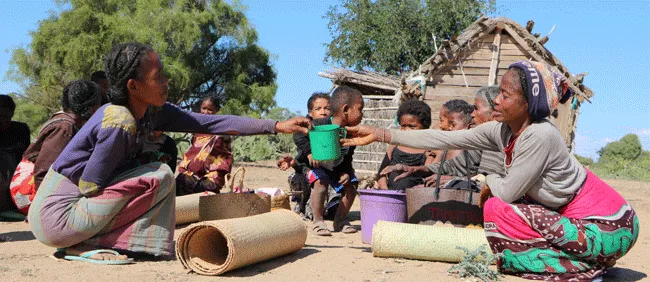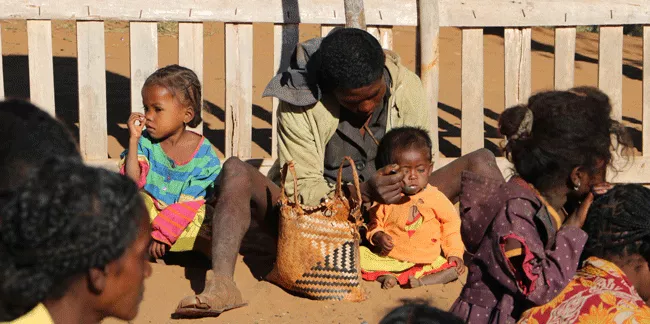Drought-triggered famine spreading in Madagascar

‘We have to save lives before anything else!’
Jean Francois Lepetit, national director of SOS Children’s Villages in Madagascar, and Jean Pierre Tombozandry, regional director of SOS Children’s Villages in Madagascar in the area of Androy, speak about the current humanitarian crisis that is unfolding on the island. A drought-triggered famine is spreading in the southern parts of Madagascar, putting hundreds of thousands of people, especially children, at risk.
How many people are affected by the drought and the resulting famine?
In the south of Madagascar around 1.3 million people are affected by food insecurity, 730,000 of them are children. In the last trimester, 14,000 people have been suffering from famine, this trimester we estimate that the number of affected people has risen to 28,000.
What are the chances for improvement of the situation?
This is the most acute drought in the last 40 years – and it comes on top of the pandemic. This region is usually affected by drought, but this year twice as many people are affected by food insecurity. We expect the next rain will be in May next year; that is the time when seeds are usually planted. There are almost nine months to go. The situation will worsen if it doesn’t rain. Food prices are increasing steadily, leaving many people unable to afford food.

Can you describe how children are affected?
The children look so bad; it is hard to even speak about it. They are incredibly thin. Lots of them stopped going to school. Many people have been wearing the same dirty clothes for months now, since there is no water to wash anything. In the remote areas, where we do not have any projects, the situation is even worse.
What are people doing to survive?
They have been eating cactus fruits and tamarinds for months. Most people are selling all their belongings in order to survive. Some even prefer to eat the seeds they have for the next planting season, but that only fuels this vicious cycle. People are getting more desperate. Some already tried to kill themselves; they do not want to live anymore.
How is SOS Children’s Villages helping?
In the six most affected communities in the regions of Androy and Atsimo-Andrefana, we provided food – rice, cereal and beans - for 1,600 families over two weeks. Also supplementary food for more than 2,000 children, especially for those under five, and pregnant women and general health care assistance. We also help the affected families with psychosocial support. Afterwards, we paid cash for community work (i.e. pond, road rehabilitation/construction) to the same families for 60 days.
Our usual work in the area is focused on community support; people do not live by themselves here, they live as a community. We have a holistic approach. Normally, we offer basic health services and education for the families. We try not to develop too much dependence; we do not want these people to live on a base of pity. We want them to earn their salaries and to be proud of themselves. Therefore, instead of just delivering supplements, we pay them for doing community work, so they can buy their own food. Our general goal is for these families to become economically self-sufficient.
But now, in this terrible situation, there is no hope for self-sufficiency. We are working on emergency relief. At this moment, we have to save lives before anything else.
For us it is important to support sustainable development. That means we don’t go to an area, hand out food for free and leave after some time. We are not only a humanitarian actor there but we are part of the community. We started our work in southern Madagascar in 2011 because of a drought – we are still there, we did not leave these people. Our staff members are people from the community working for the community. They won’t be able to forget these people because they are these people themselves.
How are you personally affected by this crisis?
Lepetit: Sometimes, the situation is overwhelming. This problem is immense and nobody seems to be looking at it. There is not even water to wash, so they drink dirty water. I ask myself, how can we leave people in this inhuman situation?
Tombozandry: When I leave my house in the morning to go to the office, I see people sitting around, waiting for anyone to give them food. Sometimes, I just want to cry, it really makes me sad seeing them. Some people are leaving the area with their kids, all of them in dirty clothes, carrying their bags and children. It‘s one thing to see these terrible images on TV. But it is completely different to see all of this in real life. I can’t even describe it.
How does the COVID-19-pandemic impact your work?
It is really difficult. People don’t care about the pandemic – if we hand out masks, hygiene articles or speak about social distancing, they look at us as if we are crazy. People who don’t have anything in their stomach don’t care about a pandemic. It’s hard for us to explain that COVID-19 can kill as well while these people just think about how their families will survive this famine.

Madagascar is already suffering the consequences of global climate change, i.e. droughts like this one occur more often. What is most needed to address this problem?
The El Niño phenomenon reinforcing this drought, it occurs around every four years. Yet, it is worse than normal; there was almost no rain for four years now. This is a result of global climate change. It is important to say that these people living in the south of Madagascar have not polluted the Earth, but they are the ones affected by the consequences. They pay for their own negative use of the environment but also for the negative comportment of citizens of industrial countries.
We think it is important to bring environmental education to the people. Deforestation is a huge problem here: people cut forests for firewood and to build houses. Many of them are illiterate, they don’t know about climate change. To contribute to a change, we have a very promising project about social, economical and ecological development. Through a partnership with a Peruvian university, young people from our SOS Children’s Villages programs in Peru are studying a master’s in molecular biology. The climate there is similar to ours. Afterwards they come back to help improve cultivation and agricultural systems here in Madagascar.
As you mentioned, the climate crisis was not caused by the people who are now suffering from this drought and famine, but the industrial countries…
We have to understand that there is an interdependence of all human beings. The way people live in industrial countries affects people in other regions, like southern Madagascar. They must change their behavior. What we are experiencing here now could happen to Europe in a century. Therefore, our appeal to the industrialized world is: show responsibility! Support the survival of the people who are affected now! We need to respect humans, animals and the Earth!
At SOS Children’s Villages, we want the most vulnerable children to have a good and sustainable life. How is this possible when life itself is dying? We have to change our way of living – in southern Madagascar and everywhere else. We must stand together, because solidarity means to have solid links. Those are needed more than ever.
